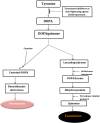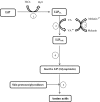Lignin peroxidase functionalities and prospective applications
- PMID: 27605423
- PMCID: PMC5300883
- DOI: 10.1002/mbo3.394
Lignin peroxidase functionalities and prospective applications
Abstract
Ligninolytic extracellular enzymes, including lignin peroxidase, are topical owing to their high redox potential and prospective industrial applications. The prospective applications of lignin peroxidase span through sectors such as biorefinery, textile, energy, bioremediation, cosmetology, and dermatology industries. The litany of potentials attributed to lignin peroxidase is occasioned by its versatility in the degradation of xenobiotics and compounds with both phenolic and non-phenolic constituents. Over the years, ligninolytic enzymes have been studied however; research on lignin peroxidase seems to have been lagging when compared to other ligninolytic enzymes which are extracellular in nature including laccase and manganese peroxidase. This assertion becomes more pronounced when the application of lignin peroxidase is put into perspective. Consequently, a succinct documentation of the contemporary functionalities of lignin peroxidase and, some prospective applications of futuristic relevance has been advanced in this review. Some articulated applications include delignification of feedstock for ethanol production, textile effluent treatment and dye decolourization, coal depolymerization, treatment of hyperpigmentation, and skin-lightening through melanin oxidation. Prospective application of lignin peroxidase in skin-lightening functions through novel mechanisms, hence, it holds high value for the cosmetics sector where it may serve as suitable alternative to hydroquinone; a potent skin-lightening agent whose safety has generated lots of controversy and concern.
Keywords: decolourization; lignin peroxidase; ligninolytic enzymes; melanin oxidation; peroxidases.
© 2016 The Authors. MicrobiologyOpen published by John Wiley & Sons Ltd.
Figures




Similar articles
-
Insights into lignin degradation and its potential industrial applications.Adv Appl Microbiol. 2013;82:1-28. doi: 10.1016/B978-0-12-407679-2.00001-6. Adv Appl Microbiol. 2013. PMID: 23415151
-
Harnessing the potential of white rot fungi and ligninolytic enzymes for efficient textile dye degradation: A comprehensive review.Water Environ Res. 2024 Jan;96(1):e10959. doi: 10.1002/wer.10959. Water Environ Res. 2024. PMID: 38204323 Review.
-
Phenolic mediators enhance the manganese peroxidase catalyzed oxidation of recalcitrant lignin model compounds and synthetic lignin.Fungal Genet Biol. 2014 Nov;72:137-149. doi: 10.1016/j.fgb.2014.07.008. Epub 2014 Aug 7. Fungal Genet Biol. 2014. PMID: 25108071
-
Lignin degradation by selected fungal species.Bioresour Technol. 2013 Jun;138:117-23. doi: 10.1016/j.biortech.2013.03.182. Epub 2013 Apr 4. Bioresour Technol. 2013. PMID: 23612169
-
Microbial lignin peroxidases: Applications, production challenges and future perspectives.Enzyme Microb Technol. 2020 Nov;141:109669. doi: 10.1016/j.enzmictec.2020.109669. Epub 2020 Sep 15. Enzyme Microb Technol. 2020. PMID: 33051019 Review.
Cited by
-
Multiplexed CRISPR/Cas9-Mediated Knockout of Laccase Genes in Salvia miltiorrhiza Revealed Their Roles in Growth, Development, and Metabolism.Front Plant Sci. 2021 Mar 18;12:647768. doi: 10.3389/fpls.2021.647768. eCollection 2021. Front Plant Sci. 2021. PMID: 33815454 Free PMC article.
-
Laccase Mediator Cocktail System as a Sustainable Skin Whitening Agent for Deep Eumelanin Decolorization.Int J Mol Sci. 2022 Jun 2;23(11):6238. doi: 10.3390/ijms23116238. Int J Mol Sci. 2022. PMID: 35682916 Free PMC article.
-
Highly stable and tunable peptoid/hemin enzymatic mimetics with natural peroxidase-like activities.Nat Commun. 2022 May 31;13(1):3025. doi: 10.1038/s41467-022-30285-9. Nat Commun. 2022. PMID: 35641490 Free PMC article.
-
Extracellular Enzyme Activities and Carbon/Nitrogen Utilization in Mycorrhizal Fungi Isolated From Epiphytic and Terrestrial Orchids.Front Microbiol. 2021 Dec 21;12:787820. doi: 10.3389/fmicb.2021.787820. eCollection 2021. Front Microbiol. 2021. PMID: 34992588 Free PMC article.
-
A Review on Metal- and Metal Oxide-Based Nanozymes: Properties, Mechanisms, and Applications.Nanomicro Lett. 2021 Jul 9;13(1):154. doi: 10.1007/s40820-021-00674-8. Nanomicro Lett. 2021. PMID: 34241715 Free PMC article. Review.
References
-
- Abadulla, E. , Robra, K. , Gübitz, G. , Silva, L. M. , & Cavaco‐Paul, A. (2000). Enzymatic decolourization of textile dyeing effluents. Textile Research Journal, 70, 409–414.
-
- Abdel‐Hamid, A. M. , Solbiati, J. O. , & Cann, I. K. O. (2013). Insights into lignin degradation and its potential industrial applications. Advances in Applied Microbiology, 82, 1–28. - PubMed
-
- Achten, C. , Cheng, S. , Straub, K. L. , & Hofmann, T. (2011). The lack of microbial degradation of polycyclic aromatic hydrocarbons from coal‐rich soils. Environmental Pollution, 159, 623–629. - PubMed
-
- Achten, C. , & Hofmann, T. (2009). Native polycyclic aromatic hydrocarbons (PAH) in coals – A hardly recognized source of environmental contamination. Science of the Total Environment, 407, 2461–2473. - PubMed
-
- Ahrens, M. J. , & Morrisey, D. J. (2005). Biological effects of unburnt coal in the marine environment. Oceanography and Marine Biology, 43, 69–122.
Publication types
MeSH terms
Substances
LinkOut - more resources
Full Text Sources
Other Literature Sources
Medical

